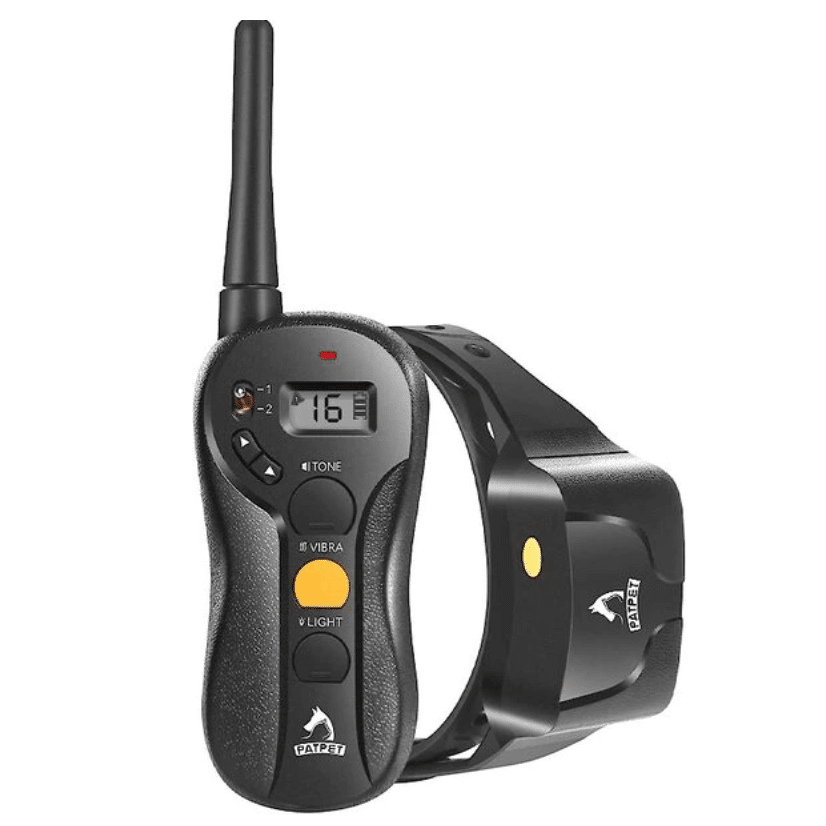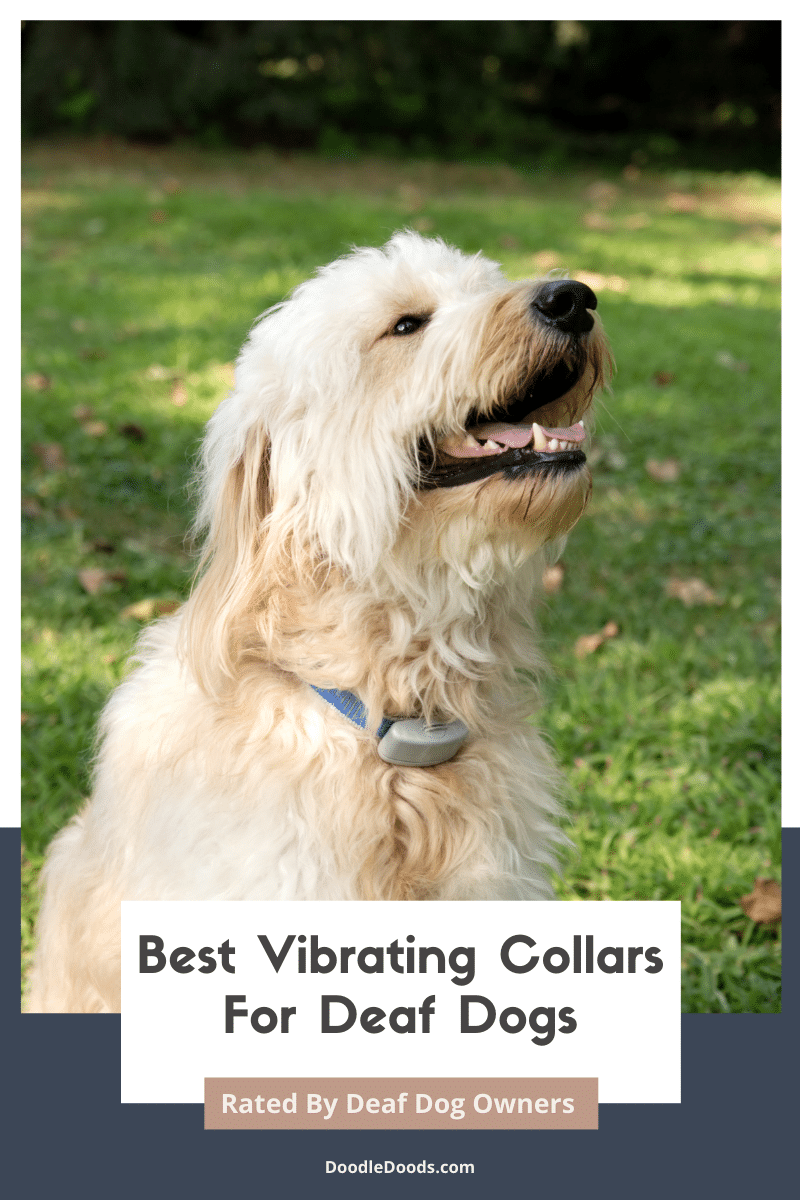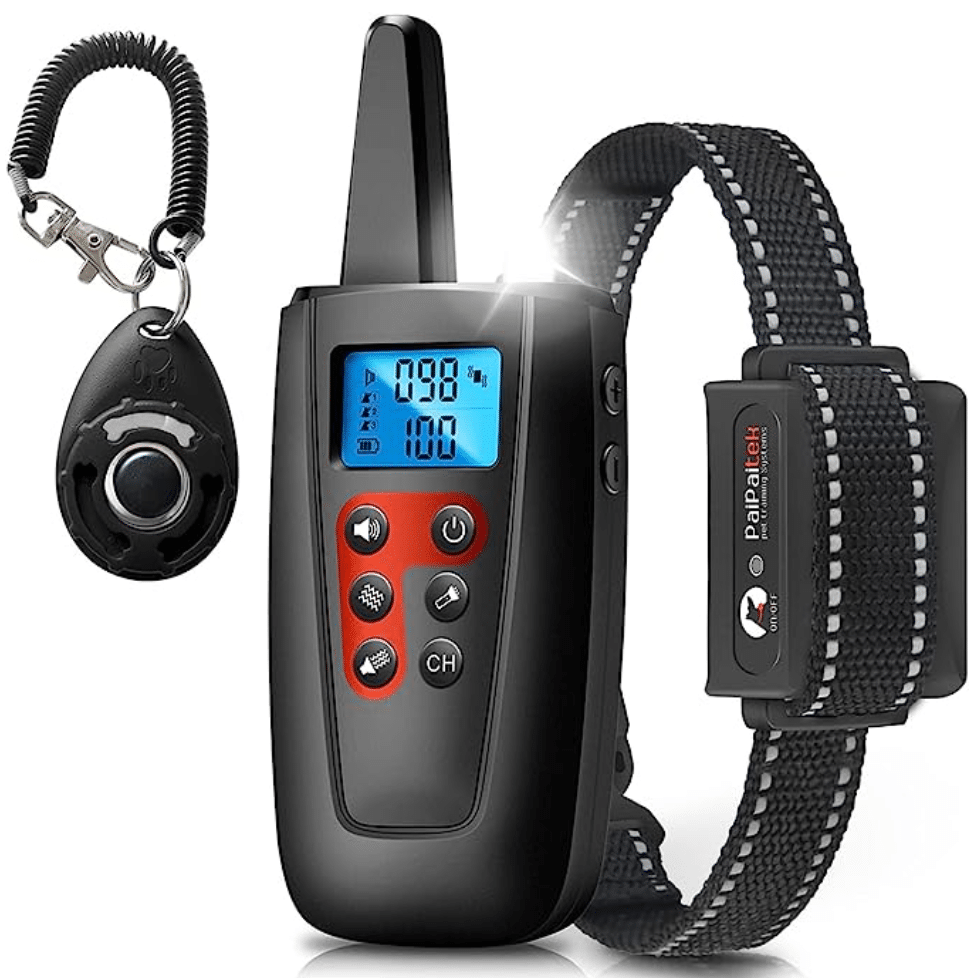While some dogs may be deaf from birth, others can start to lose their hearing as they get a little older. If your pup is hearing impaired, for whatever reason, you might find that one of the toughest things is getting their attention. Even if they are people-pleasing pups at heart, being unable to get them to notice you make training tricky and recall impossible… until you give one of these vibrating collars for deaf dogs a whirl, that is!
These handy devices can help you do all the things you thought would not be possible with your pet. Here we’ll take a look at some of the best vibrating collars for deaf dogs based on the product specifications as well as what other pet owners have to say.
Table of Contents
- What Exactly Are Vibrating Collars?
- What Can You Do With A Vibrating Collar?
- Vibrating Collars For Deaf Dogs: Buyer’s Guide
- Best Vibrating Collars For Deaf Dogs: Buyer’s Guide
- How To Safely Use Vibrating Collars For Deaf Dogs
- Vibrating Collars For Deaf Dogs: Frequently Asked Questions
Top 3 Vibrating Collars For Deaf Dogs According To Reviews
If you’ve done all the research and are just here for the recommendations, here they are, along with links to where you can purchase the products. However, if you’d like to learn a little more about what vibrating collars for deaf dogs are, what you can do with them, and how you and your hearing-impaired pup could benefit from using one, keep reading.
-
Pick #1:
PATPET P630 No Electric Shock 2000-ft Remote Dog Training Collar – With a 600-yard range and a variety of different vibration options to choose from, the Patpet No Shock Collar is a useful and versatile collar that does what you need it to.
-
Pick #2:
Brapezie Vibrating Dog Collar No Shock, Dog Training Collar – It’s stylish look and wallet-friendly price are the first attractions of Brapezie’s Dog Collar, but they are by no means the best; that would be its incredible 45-day battery life!
-
Pick #3:
Paipaitek No Shock 3300-ft Dog Training Collar – If you’re looking for a vibrating collar with some serious range, look no further than Paipaitek’s No Shock Collar, which can transmit its signal more than half a mile!
What Exactly Are Vibrating Collars?
Vibrating collars, or vibration collars, pretty much do what they say on the tin. A device is attached to your pup by means of a collar, and each time you press a button on a remote, the device vibrates against their neck. Now these collars are typically marketed towards hearing-impaired hounds. Instead, they may be sold as more in-demand anti-barking devices or, in a better way, as training tools. The idea is to get their attention when voice commands can’t or aren’t doing the trick.
However, their use as training tools is controversial. This is because the vital distinction between vibrating collars and shock ones isn’t well known. Most pet owners tend to think they are one and the same thing. The issue with this is that these are two very different devices with widely different purposes. While shock collars are aimed at preventing disruptive or otherwise unwanted behaviors by delivering a painful shock as punishment, a vibrating collar is more about training for wanted actions using positive reinforcement.
The problem with shock collars is that most canine experts these days appreciate that the punishment simply doesn’t work as a training tool. Sure, it may get your pet to stop barking or jumping up. However, in the long term, it is more likely to make them anxious, aggressive and will likely have a detrimental impact on your relationship with your dog. By training with treats, toys, and other rewards, your pup is more likely to respond to you and what you’re asking of them in a positive way, and a vibrating collar can help with this.
What Can You Do With A Vibrating Collar?
Yet, as most people are unaware of vibration collars and what they are for, they tend to expect that the vibrations will do what the shocks are meant to – deter their dog from doing something – just in a more humane way. In thinking that they are completely missing the point, so, unfortunately, vibration collars get a bad rap, and it’s actually completely unnecessary. In fact, owners of hearing-impaired dogs usually find them quite invaluable. Dogs can be trained to respond to vibrations as cues to action.
For instance, imagine that you have let your pooch off to get a little exercise in the park. Now, if they are busy sniffing away at the grass or some other dog’s special place, they won’t see any hand gestures you use to attract them back to you when it’s time to leave. Now think instead of pressing a button on a remote that will vibrate their collar and, if they have been trained correctly, call them right back to you, or at least have them look up to see your hand cues. Can you see the beauty of it?
Now, you’re obviously going to need to teach your four-legged to behave in the right way to the vibrations. If you’re an old hand at training, and you find the right product, you might even be able to find a way to link up specific vibration patterns or strengths with different actions – ‘come’ or ‘sit’ or ‘stay.’ It goes without saying that it will take a little bit more patience, but it’s definitely possible with the clever Doodle. And the great thing about using a collar is that you’ll always be sure your message was received.
Vibrating Collars For Deaf Dogs: Buyer’s Guide
When it comes to vibrating collars for deaf dogs, you’re certainly not short of options – and great ones at that. However, you definitely don’t want to be spending a chunk of change on something that’s not going to do what you want. As such, be sure to check the specs (not to mention the reviews) before you dive into the buying part.
At a bare minimum, be on the lookout for:
Range
The range of the collar should be one of your primary considerations if you’re looking to use it outdoors. You’ll need to factor in how far away you imagine your pup will be from you at any given time to know how much you will require. After all, you don’t want to lose contact with your dog right at the point you’d like them to return to you. This is also a key consideration if you have a larger property and like to let your hound roam free during the day. In this case, the bigger, the better is your best bet.
Adjustability
When it comes to the amount of vibration you’ll need, every dog is different. They come in a variety of sizes, with thicker or finer, longer or shorter hair and a higher or lower tolerance for ignoring vibrations. As such, it helps if you opt for an adjustable collar so you can find the level that’s going to work for your pooch. That said, once you find the lowest one that gets your dog’s attention, stick there. The neck is a sensitive area, and you don’t want to cause any discomfort.
Battery Life
You don’t want to waste time waiting for a collar to charge. That’s why you’ll want to pick one that doesn’t take too long to get to full juice and that lasts a goodly long time once it does. This is especially important if you’re the outdoorsy sort who likes to go on lovely long hikes or camp out for a night or two. You don’t want batteries letting you down when you need them the most. Many units these days tend to reach full power with a couple of hours’ charge and will last for days on that.
Durability
As your hound will be out and about in their snazzy new collar, running through long grass in all weathers and maybe even doing a little swimming, obviously, you want to make sure that it’s going to last the distance. As with most tech, this can be a little tough to guarantee. Make the wrong choice, and your new toy won’t last as long as its first rain shower. For this reason, be sure to pick something that will not only deal with a few bumps and scratches, but that can withstand fairly extreme weather too.
Comfort & Fit
It goes without saying that you’ll want the collar to fit your dog well. After all, you want them to be able to run and have fun to their heart’s content, not be slowed down at every pace by something bulky and painful. Aside from the obvious, another benefit vibrating collars have over shock ones is that they don’t have those painfully-digging-in prongs. Your pup should be able to wear this kind of collar just as they would the regular kind, easily, comfortably, and for as long as you want them to.
Best Vibrating Collars For Deaf Dogs: Buyer’s Guide
Best For Comfort & Convenience: PATPET P630 No Electric Shock 2000-ft Remote Dog Training Collar
If you’re looking for a good starter collar or a nice all-rounder, you can’t go far wrong with Patpet’s No Electric Shock one. It comes with a fair range of up to 600 yards, 16 vibration levels to select from, and a battery life of around five and a half days for the collar and ten for the remote. These are all good specs for the price. Beyond that, the collar itself is IPX7 waterproof, which means it can be submerged in shallow water for up to 30 minutes, so it should have no problems handling a little bad weather.

The reviews are decent, with 87% of buyers saying they would recommend the product to a friend. The vibration is mild enough not to cause pain or distress, yet, with the right training is definitely enough to be felt and responded to. In fact, many pet parents have had positive results with the collar right from the start – even before training. And those with dogs with pretty high prey drives say it works wonders to keep their pets by their side even with distractions all around.
What We Like About It: An excellent training tool that is great for getting and holding attention. It’s useful for both recall and for encouraging wanted actions with the help of positive reinforcement.
What’s Not Quite So Good: Negative reviews seem mostly to be from those hoping the collar would be more of a deterrent to prevent unwanted behaviors such as barking.
Best For Extended Long Battery Life: Brapezie Vibrating Dog Collar No Shock, Dog Training Collar
For something you can really take out into the wild (or if you happen to be the kind of person who forgets to put things on charge), the Brapezie Collar might be the right pick. While it has much the same features as the Patpet: tone and vibration options, 16 levels to choose from, a 600-yard range, and a waterproofness of IPX7, it’s that amazing battery life that really caught our attention. A single 2-hour charge gives the transmitter a staggering 45 days and the collar 15. You can’t say better than that!
“Easy and effective” and “Does what it’s supposed to do” sum up the comments for this fab buy. As the reviewers say, it’s pretty much an essential tool for gentle training. It’s especially useful if you’re looking to train hearing-impaired working dogs – or any kind of working dog, for that matter, if you don’t want to be yelling into the wind. Other features dog owners love include the flashlight, which makes finding your pet in the dark easier, and the split connection charger for charging both devices simultaneously.
What We Like About It: A nicely designed collar that looks good, fits well, and aids training – and you’ve got to admire that truly impressive battery life.
What’s Not Quite So Good: Many reviewers comment that this collar isn’t well suited to smaller breeds, so if your pup is more on the mini side, you might want to look elsewhere.
Best For Super Long Range: Paipaitek No Shock 3300-ft Dog Training Collar
Last but not least, we have the Paipaitek No Shock Collar. This one is great for active, run-loving hounds, especially because of its impressive 3300-ft range. That’s more than 1000 yards or half a mile! So if you’re happiest when your pal is free to roam as they please, this is definitely the collar for you. Especially so if you have more than one dog you would like to communicate with from a single collar – with this one, you can reach up to three. And with 100 vibration levels, you have many options here.
Those who have tried the Paipaitek in collaboration with their usual approach have been highly impressed. As one reviewer explains, “It’s a great way to train my dogs without using harsh methods.” A further benefit is the handy adjustable collar, and the many MANY vibration levels make it a great choice for dogs of all sizes. Owners also love that it’s more humane for their dog to wear than the shock collar, with no protruding prongs that dig in and cause discomfort—a good choice for all.
What We Like About It: With similar features to the other two products, this is a good pick. However, that massive range gives it the edge for hiking lovers and those with super boisterous pups that need a ton of exercise.
What’s Not Quite So Good: Some pet parents mention that the buttons on the remote can be a little sensitive, so you’ll have to be careful carrying the device to be sure you don’t hit against them accidentally and wind up confusing your pet.
How To Safely Use Vibrating Collars For Deaf Dogs
Training a deaf dog can, for obvious reasons, be a little more tricky than training a non-hearing impaired one, even if you’re relatively experienced at training dogs. However, with a little extra effort (not to mention patience), it can be done.
Here’s how:
- The first and most important step in training your pup is selecting the right tools for the job. You want a collar that is comfortable to wear and provides a low level of vibration that your dog will respond to without it bothering them too much.
- Have plenty of treats to hand to help your pet get to grips with what you’re asking of them. In this way, you can be sure that training will always be a positive experience, and your pup won’t just respond well but with relish.
- Identify vibration patterns for each command and be consistent when teaching them. When your pup finally links the ‘command’ to the action, reward them well for it, and then practice, practice, practice!
- Using hand signals alongside the collar. In that way, you have something to fall back on if the collar does let your down. Plus, you’re also teaching your pup to pay attention to you above everything else.
- When you start training, do so in a controlled environment. This is especially important when it comes to recall. You want to be sure that your hound has this one down before you let them go free in a place where you have less control.
- Aim to only use the vibrating collar when absolutely necessary – for attention or training. If you use it too often for anything else, your pal could easily become desensitized to the vibration and start ignoring it.
Vibrating Collars For Deaf Dogs: Frequently Asked Questions
Unlike shock collars, which are designed to prevent unwanted behavior using punishment in the form of pain, vibrating collars act as cues to encourage wanted actions with the help of positive reinforcement. In this way, they are perfectly safe for most dogs. That being said, they might not be suitable for overly anxious or sensitive pets.
While a deaf dog won’t be able to hear any noises emitted by training collars, they will be able to feel the vibrations. If you pair these vibrations with hand cues to encourage your pet to do certain actions, e.g., come, sit, stay, and then reinforce the actions with treats, toys, or other rewards, you should be able to effectively train your hearing-impaired pup.
Used in the right way, with a physically and mentally healthy hound vibrating collars should have absolutely no side effects at all. The vibration, which is a little like that of your phone, will cause no discomfort whatsoever. However, with a rescue or otherwise nervy pup, you may have a few problems as the collar might cause them distress.
Final Thoughts
If you’re looking for an effective way to communicate with your hearing-impaired pet, especially while letting them run free in the park, vibrating collars for deaf dogs are certainly something to look into. They can be very effective training tools used for recall and also for encouraging other kinds of wanted behavior. However, take care with sourcing the right one, as many vibration collars around have nasty shock functions that could serve actually damage the relationship between you and your pet. That’s why we have come up with these recommendations for humane vibrating collars for deaf dogs to help you find the right one for you and your pet. Happy shopping 🙂
Learn How to Care for Your Doodle Puppy!

Perfect for first-time Doodle parents, get ALL your questions answered, including questions new Doodle parents don’t even think to ask.
Plus, get $700 worth of Bonus Materials for FREE, including:- Doodle Parenthood Community and Support Group ($190 value)
- Doodle Puppy Growth Tracker ($20 value)
- EMERGENCY Cheatsheet: When To Call The Vet Immediately ($50 value)
- HELP! Button ($145 value)
- And SO MUCH MORE!











I use a SportDog collar on my dog with the plastic prongs (not the metal tipped ones) so it can’t deliver a shock. I wish I’d known about collars with varying levels of vibration, because I’m sometimes uncertain whether he notices the vibration when he’s engrossed in socialising with other dogs. He’s about 14 years old now and seems to have some hearing loss. On the other hand, he’s also disobedient on occasion. I’ve used this collar for some years now to back up recall. I got it to stop him chasing and killing chickens, which had happened twice on walks, or haring off to chase cats. Then, I did use the shock function on the lowest possible setting that he showed any reaction to, and only if he didn’t respond to the bleep, followed by vibration. Yes, I agree shock collars should be illegal, as they are now here in France, but it would have been cruel not to have allowed him to run off lead and I’d exhausted all other ways of training recall. I should add that he has never behaved aggressively to another dog or a human and is very skilled at making friends and avoiding conflict. If anyone around seems scared of dogs, or if there are young children who might be nervous, I put him on the lead. Once the chickens were safe, I stopped using the shock and switched to only using the bleep and vibration. One thing to bear in mind when using a vibration collar is that the collar can’t indicate the direction you are calling from. At night you can use a light to show where you are, but that’s no use in the daytime. Though he can mainly hear me still, if I’m close, I did notice the other day, when he was about 30 metres away, that when I first called him and then used the bleep and the vibration on the collar he looked around trying to work out where I was. He had the sense to stand still until he saw me and then came back.
January 31, 2024 at 5:14 pmThough he no longer disappears over the horizon, as he did when younger and has learned that chasing hens, cats or any other animals is strongly disapproved of, he does sometimes turn to look at me when I’m calling him and then scampers off at high speed (but in a bouncy way and with his tail in the air), to check out the smells around the corner before coming back. He also no longer runs rings around me and the car at the end of a country walk to delay getting into the car for as long as possible. I wish I’d been warned not to adopt a dog with a sense of humour!